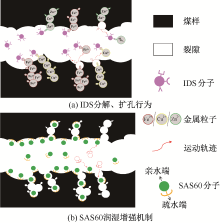| [1] |
周宏伟, 刘泽霖, 孙晓彤, 等. 深部煤体注水过程中渗流通道演化特征[J]. 煤炭学报, 2021, 46(3): 867-875.
|
|
ZHOU Hongwei, LIU Zelin, SUN Xiaotong, et al. Evolution characteristics of seepage channel during water infusion in deep coal samples[J]. Journal of China Coal Society, 2021, 46(3): 867-875.
|
| [2] |
翁安琦, 袁树杰, 王晓楠, 等. 煤层注水降尘中表面活性剂复配应用研究[J]. 中国安全科学学报, 2020, 30(10): 90-95.
doi: 10.16265/j.cnki.issn 1003-3033.2020.10.013
|
|
WENG Anqi, YUAN Shujie, WANG Xiaonan, et al. Study on application of surfactant compound in coal seamwater injection for dust reduction[J]. China Safety Science Journal, 2020, 30(10): 90-95.
doi: 10.16265/j.cnki.issn 1003-3033.2020.10.013
|
| [3] |
高建良, 关孟瑶, 张琛, 等. 高阶煤润湿过程中水分运移的低场核磁共振试验[J]. 中国安全科学学报, 2023, 33(10): 46-52.
doi: 10.16265/j.cnki.issn1003-3033.2023.10.0009
|
|
GAO Jianliang, GUAN Mengyao, ZHANG Chen, et al. Low-field nuclear magnetic resonance tests characterizing moisture transport during wetting of high-rank coal[J]. China Safety Science Journal, 2023, 33(10): 46-52.
doi: 10.16265/j.cnki.issn1003-3033.2023.10.0009
|
| [4] |
李懿, 陆伟, 李金亮, 等. 煤层注射成胶型抑尘剂影响因素及抑尘效果研究[J]. 中国安全科学学报, 2024, 34(3): 171-178.
doi: 10.16265/j.cnki.issn1003-3033.2024.03.1751
|
|
LI Yi, LU Wei, LI Jinliang, et al. Study on influencing factors and dust suppression effect of coal seam injection gum-forming dust suppressant[J]. China Safety Science Journal, 2024, 34(3): 171-178.
doi: 10.16265/j.cnki.issn1003-3033.2024.03.1751
|
| [5] |
YU Changfei, JIANG Bingyou, YUAN Liang, et al. Inhibiting effect investigation of ammonium dihydrogen phosphate on oxidative pyrolysis characteristics of bituminous coal[J]. Fuel, 2023, 333:DOI: 10.1016/j.fuel.2022.126352.
|
| [6] |
XIE Hongchao, NI Guanhua, LI Shang, et al. The influence of surfactant on pore fractal characteristics of composite acidized coal[J]. Fuel, 2019, 253: 741-753.
doi: 10.1016/j.fuel.2019.05.073
|
| [7] |
NI Guanhua, XIE Hongchao, LI Shang, et al. The effect of anionic surfactant (SDS) on pore-fracture evolution of acidified coal and its significance for coalbed methane extraction[J]. Advanced Powder Technology, 2019, 30(5): 940-951.
doi: 10.1016/j.apt.2019.02.008
|
| [8] |
HAN Weibo, ZHOU Gang, ZHANG Qingtao, et al. Experimental study on modification of physicochemical characteristics of acidified coal by surfactants and ionic liquids[J]. Fuel, 2020, 266: DOI: 10.1016/j.fuel.2019.116966.
|
| [9] |
WANG Cunmin, ZHOU Gang, JIANG Wenjing, et al. Preparation and performance analysis of bisamido-based cationic surfactant fracturing fluid for coal seam water injection[J]. Journal of Molecular Liquids 2021, 332: DOI: 10.1016/j.molliq.2021.115806.
|
| [10] |
YAN Song, HUANG Qiming, QIN Cunli, et al. Experimental study of wetting-seepage effect of microemulsion for the coal seam water injection[J]. Journal of Molecular Liquids, 2021,336: DOI: 10.1016/j.molliq.2021.116361.
|
| [11] |
KAURIN A, GLUHAR S, TILIKJ N, et al. Soil washing with biodegradable chelating agents and EDTA: effect on soil properties and plant growth[J]. Chemosphere, 2020, 260: DOI: 10.1016/j.chemosphere.2020.127673.
|
| [12] |
GLUHAR S, KAURIN A, LESTAN D. Soil washing with biodegradable chelating agents and EDTA: technological feasibility, remediation efficiency and environmental sustainability[J]. Chemosphere, 2020, 257: DOI: 10.1016/j.chemosphere.2020.127226.
|
| [13] |
CHEN Shuya, XIE Kunzhi, SHI Yanping, et al. Chelasting agent-introduced unconventional compound acid for enhancing coal permeability[J]. Journal of Petroleum Science and Engineering, 2021, 199: DOI: 10.1016/j.petrol.2020.108270.
|
| [14] |
NI Guanhua, SUN Qian, XUN Meng, et al. Effect of NaCl-SDS compound solution on the wettability and functional groups of coal[J]. Fuel, 2019, 257: DOI: 10.1016/j.fuel.2019.116077.
|
| [15] |
REN Bo, YUAN Liang, ZHOU Gang, et al. Effectiveness of coal mine dust control: a new technique for preparation and efficacy of self-adaptive microcapsule suppressant[J]. International Journal of Mining Science and Technology, 2022, 32(6): 1181-1196.
|
| [16] |
SHI Guoqing, HAN Cong, WANG Yanming, et al. Experimental study on synergistic wetting of a coal dust with dust suppressant compounded with noncationic surfactants and its mechanism analysis[J]. Powder Technology, 2019, 356: 1077-1086.
doi: 10.1016/j.powtec.2019.09.040
|
| [17] |
ZHAO Zidong, CHANG Ping, XU Guang, et al. Comparison of the coal dust suppression performance of surfactants using static test and dynamic test[J]. Journal of Cleaner Production, 2021, 328: DOI: 10.1016/j.jclepro.2021.129633.
|
| [18] |
LIU Zhen, ZHU Muyao, YANG He, et al. Study on the influence of new compound reagents on the functional groups and wettability of coal[J]. Fuel, 2021, 302: DOI: 10.1016/j.fuel.2021.121113.
|
| [19] |
ZOU Quanle, ZHANG Tiancheng, MA Tengfei, et al. Effect of water-based SiO 2 nanofluid on surface wettability of raw coal[J]. Energy, 2022, 254: DOI: 10.1016/j.energy.2022.124228.
|
| [20] |
WANG Xiaohan, JIANG Bingyou, YUAN Liang, et al. Study on coupling chelating agent and surfactant to enhance coal wettability: experimental and theoretical discussion[J]. Fuel, 2023, 342: DOI: 10.1016/j.fuel.2023.127861.
|
| [21] |
SHI Guoqing, QI Jiamin, WANG Yanming, et al. Synergistic influence of noncationic surfactants on the wettability and functional groups of coal[J]. Powder Technology, 2021, 385: 92-105.
doi: 10.1016/j.powtec.2021.02.056
|
| [22] |
RAMIREZ-LEAL R, CRUZ-CAMPAS M, ESTUARDO-MORENO H. Characterization of PM10 particles by SEM-EDS[J]. Microscopy and Microanalysis, 2018, 24(S1): 1070-1071.
|
| [23] |
XU Lianman, WEI Hao, KANG Xinyue, et al. Study on the change law of physical and mechanical properties and wetting mechanism of coal body under the synergistic effect of chelation-adsorption[J]. Energy Sources, Part A: Recovery, Utilization, and Environmental Effects, 2022, 44(2): 4481-4493.
|
| [24] |
ANGGARA F, SASAKI K, SUGAI Y. Mineral dissolution/precipitation during co2 injection into coal reservoir: a laboratory study[J]. Energy Procedia, 2013, 37: 6722-6729.
|



























